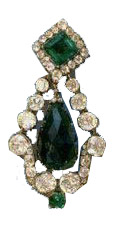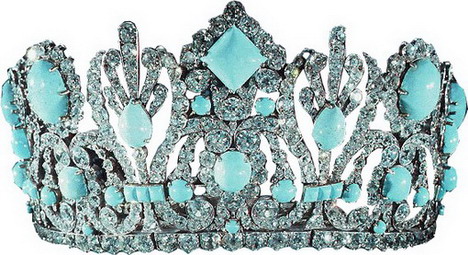The Regent Diamond
The Regent Diamond
Origin of name The term "parure" that came into popular usage in France and later other European countries in the 17th century, refer to an entire wardrobe or suite of matching jewelry, which became a status symbol for the royalty, noble and wealthier classes. A parure meant for the royalty usually included a diadem, tiara, comb, bandeau, choker, necklace, earrings, brooch, stomacher, bracelets and rings. Parures are usually named according to the types of precious or semi-precious stones, used in the setting of its components. The Marie-Louise Parure under consideration is set mainly with emeralds and diamonds. Hence the name "Emerald and Diamond Parure." Like wise we can have combination's like "Sapphire and Diamond Parure", "Ruby and Diamond Parure," "Amethyst and Diamond Parure" etc. where two gemstones are almost equally co-dominant. Parure where only a single type of gemstone predominates is usually given the name of such gemstone, such as "diamond parure,"
Napoleon Bonaparte, the mighty emperor of France was reported to have lavished such expensive parures on his first wife Josephine and later his second wife Marie Louise. The emerald and diamond parure was a gift of Napoleon Bonaparte to Marie Louise on the occasion of their wedding, which was solemnized in the year 1810, and thus came to be known as the "Emerald and Diamond Parure of Marie Louise."
Components of the Emerald and Diamond Parure of Empress Marie-Louise
The following are the components of the exquisitely crafted and renowned Emerald and Diamond Parure of Empress Marie-Louise :-
1) Emerald and Diamond Diadem
2) Emerald and Diamond Necklace
3) A pair of Emerald and Diamond Earrings
4) Emerald and Diamond Comb
5) Emerald Belt Clasp
The completed parure was delivered to Empress Marie-Louise in March 1810.
Marie-Louise Emerald and Diamond Diadem
The word "diadem" is derived from the Latin and Greek word "diadem" which is derived from "diadem" meaning "to bind around." It is synonymous with the word "crown." The word "tiara" which is of Persian origin means a decorative, jeweled or flowered head band or semicircle, usually worn by women in the front of their hair on formal occasions. Thus the difference between a diadem and a tiara is, that while a diadem is circular going round the head, a tiara is usually semi-circular going only partially round the head in the front.
The "Marie-Louise Emerald and Diamond Diadem" had been variously referred to as a diadem and tiara by different websites. But, in keeping with the above definitions we would prefer to call it a diadem and not a tiara. as it is a circular ornamental headdress like a crown.
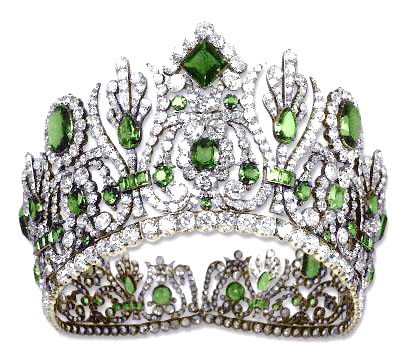
The diadem which is circular is broader in the front and slightly narrows down towards the rear. Symmetrical floral motifs have been used on the diadem, a style that was prevalent throughout the 19th century for jewelry crafting. Jewelry designs of this period reflected a naturalistic style, that used the "language of flowers" such as plant and floral motifs, which also conveyed a message of love or affection. A total of 22 large emeralds, 57 small emeralds, 1,002 brilliants and 66 rose-cut diamonds were used on the diadem. The largest emerald which is the centerpiece of the diadem weighed 12 carats, and was a square-shaped emerald surrounded by a single layer of large rose-cut white diamonds. The square emerald has been placed with one of its diagonals along the median vertical line of the front of the diadem. Thus opposite verticals of the square lie along the median vertical line. A second smaller oval-shaped emerald, also surrounded by rose-cut emeralds, is placed below the square-shaped emerald centerpiece, still along the median vertical line. Other large emeralds are placed at symmetrical positions on either side of the median line. The band that goes right round and forms the base of the diadem, is mounted with a single row of rose-cut emeralds. The entire diadem was set in silver and gold, and overall the diadem represented one of the most exquisitely crafted diadems of this design ever created, attaining a very high level of perfection and refinement in its execution, so characteristic of the highly developed jewel crafting industry in Paris during this period.
Thus it is tragic that such a priceless diadem with an inestimable artistic and historic value was allowed to be partially dismantled and its emeralds re-set in other jewelry settings, with an intention of gaining enhanced profits. However it gives a sense of relief that at least the original framework of the tiara had been preserved, the emeralds being replaced by turquoise, and lies today in the Janet Nirenberg Hooker Hall of Geology, Gems and Minerals of the National Museum of Natural History of the Smithsonian Institution.
Marie-Louise Emerald and Diamond necklace
The design of the necklace is classical in nature conforming to the architectural style developed for the period by Charles Perrier and Pierre Fontanel. The necklace is composed of 32 emeralds, 264 rose-cut diamonds and 864 brilliant-cut diamonds. The necklace set in gold and silver consists of symmetrically arranged alternating square-shaped and cushion-shaped large emeralds, surrounded by a single layer of white rose-cut emeralds, separated by smaller round-shaped emeralds, surrounded by small round brilliant-cut diamonds. There are five square-shaped emeralds, and five cushion-shaped emeralds and twelve small round-shaped emeralds. Usually only a single round-shaped emerald has been placed between a square-shaped emerald and a cushion-shaped emerald, except at the rear of the necklace where two round-shaped emeralds have been placed symmetrically on either side.
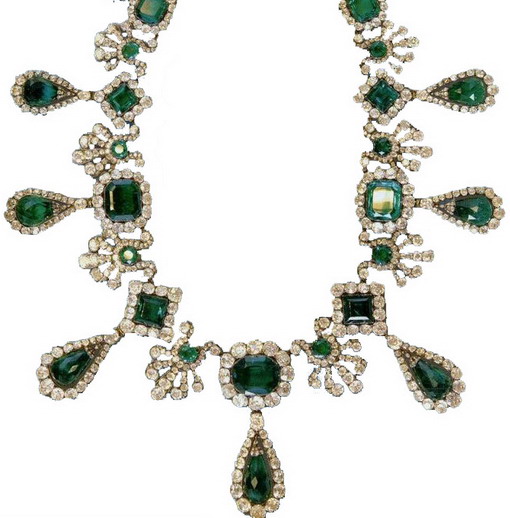
From each of the large square-shaped and cushion-shaped emeralds arise a drop-shaped or cabriolet emerald, also surrounded by diamonds increasing in size from the pointed end towards the rounded end. Cabriolets were very popular in France in the 18th and 19th centuries, particularly during the period of Napoleon Bonaparte, who is said to have gifted a 275-carat diamond cabriolet necklace to his Empress Consort Marie Louise, to celebrate the birth of their son, the future King of Rome. This necklace is also part of the Smithsonian collection in the National Museum of Natural History in Washington DC.
The small round-shaped emerald between a large square-shaped emerald and a large cushion-shaped emerald is the base of a palette derived from Greek and Roman art. As there are twelve round-shaped emeralds in the necklace, there are a corresponding number of palettes. Each palette has five rays, like the five fingers of the palm. Each ray of a palette is made up of round brilliant-cut diamonds that increase in size from the base towards the tip; the largest round-brilliant being placed at the tip of each ray.
Overall the combined emerald and diamond necklace was a masterpiece of its kind ever created imparting an elegant look on its wearer especially if fair-skinned, like the Empress Marie Louise. This necklace of great historic and artistic value, and imperial provenance, was preserved in its pristine pure state, by the person who acquired it from the ancestors of Marie Louise. This indeed is a great relief to all lovers of historic artifacts and the owner of the historic piece needs the commendation of art lovers worldwide, for preserving an irreplaceable piece of the world heritage. Fortunately, the Louvre Museum in France, had taken the unprecedented step of acquiring the celebrated necklace together with a pair of earrings, also part of the original parure, for a whopping sum of 3.7 million euros, the highest ever sum of money paid by a museum for items of jewelry. It is heartening to note that at least now the Louvre Museum in France, had realized the folly of those who were instrumental in dispersing the crown jewels of France in 1887, and are leaving no stone unturned to restore the lost heritage of one of Europe's greatest nations.
Marie Louise Emerald and Diamond Earrings
Marie Louise Emerald and Diamond Earrings are based on a simple but elegant design, matching the design on the celebrated necklace. The central theme of this design is the drop-shaped emerald or cabriolet, suspended from a square-shaped emerald aligned with one of its diagonals lying vertically. The square-shaped emerald is surrounded by a row of small rounded brilliant-cut diamonds. The cabriolet hangs freely from the square-shaped emerald, but is surrounded by a loop of gold wire mounted with large rose-cut diamonds. A single round-shaped emerald is also incorporated in the loop right at its bottom.
| | |
Overall the design of the earrings matches perfectly with that of the necklace, particularly that part of the necklace with a combination of square and drop-shaped emeralds. The two earrings are composed of 6 emeralds, 20 rose-cut and 40 brilliant-cut diamonds.
The pair of emerald and diamond earrings was also part of the parure of the Empress Marie-Louise, that had miraculously escaped any tampering or alteration, like the celebrated Marie-Louise Emerald and Diamond necklace, and was purchased by the Louvre Museum under the same deal by which they acquired the celebrated necklace.
Emerald and Diamond Comb
The Emerald and Diamond Comb was said to have been made up of 23 emeralds, 54 rose-cut diamonds and 226 brilliant-cut diamonds, but unfortunately no further information on the comb is available, not even an image of the comb. If such an image was available a description of its design could have been attempted.
5) Emerald and Diamond Belt Clasp
The Emerald and Diamond Belt Clasp was said to have been made of 5 emeralds and 107 brilliants, but no further information on the piece of jewelry is available.
History of the Marie-Louise Emerald and Diamond Parure
Napoleon Bonaparte takes power as absolute dictator and later as Emperor of France
Napoleon Bonaparte, the mighty dictator of France who took power as First Consul in 1799, and later as Emperor of France in 1804, was a direct product of the French Revolution. It was the French Revolution that propelled him at an early age to the highest position in the State. The people had confidence in him for bringing many victories to France, and they expected him to bring back much-needed peace to the country, after the turmoil and uncertainty following the revolution, to end disorder, and to consolidate the political and social conquests of the revolution. But, what the people of France did not know was that Napoleon did not believe in the sovereignty of the people, in the popular will or in parliamentary debate. He had secretly nurtured in him an ambition to take the place of the deposed Bourbon Monarchs, and assume the title of the Emperor of France. Thus all his actions between 1799 and 1804, as the First Consulate was calculated towards achieving this objective. To give a semblance of legitimacy for his actions he got Pope Pius VII to come to Paris and consecrate him and crown him as the Emperor of France. Soon the court of Emperor Napoleon I surpassed the grandeur and pageantry of some of the former Bourbon Monarchs.
Napoleon's first marriage to Josephine
Josephine, the eldest daughter of Joseph Tascher de La Pagerie, married a rich young army officer Alexandre Vicente de Bearnaise in the year 1779 at the age of 16 years. Josephine was brought up in the rural atmosphere of the island of Martinique, where she lived for 15 years, before her marriage. Thus Alexander was ashamed of her rural manners and lack of sophistication, and refused to present her at the court of Marie Antoinette at Versailles. Yet, Josephine bore him two children, a daughter Hortense and a son Eugene. The indifferent attitude of Alexandre towards Josephine finally led to their separation in 1785. After the separation, she remained in Paris for several years and was determined to learn the ways of the elite high society and aristocrats. In the year 1794, at the height of the French Revolution her former husband Alexandre who was serving in the revolutionary army, fell out of favor with them and was guillotined to death.
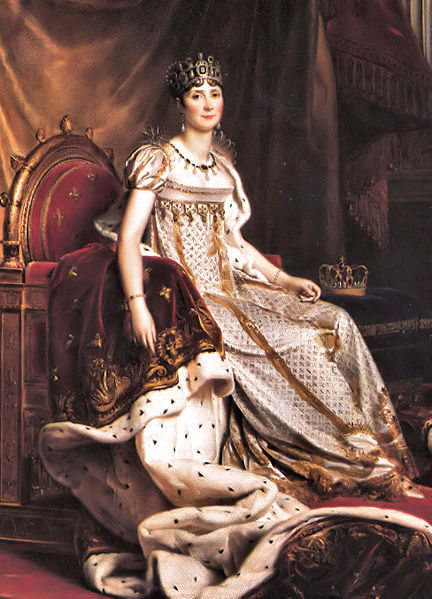
Josephine who was now a sophisticated high society lady, caught the attention of an upcoming and ambitious army officer, Napoleon Bonaparte, who fell in love with her. After the appointment of Napoleon as the commander of the Italian expedition, Josephine agreed to marry him, and the marriage took place on March 9, 1796. Napoleon appears to have been passionately in love with Josephine, but on her part she was indifferent not reciprocating his love for her. She even went to the extent of flirting with another army officer when Napoleon was away during his Egyptian campaign during 1798-99, and on his return Napoleon threatened to divorce her. Her marriage was only saved by her children who pleaded on her behalf with their step-father. The rift was healed and Napoleon forgave her for her misdeeds. After Napoleon became the first consul in 1779, she worked closely with her husband to advance his political fortunes. The couple became very close to each other and when Napoleon assumed control as the Emperor of France she was able to persuade him to conduct a fresh marriage ceremony with full religious rites, which was held only a day before his coronation by the Pope in Notre-Dame on December 2, 1804. Besides this, Josephine was able to use her husbands power and position to find good spouses for her two children by her first marriage. Her daughter Hortense was given in marriage to Napoleon's brother, Louis Bonaparte, and her son Eugene, who was appointed as the viceroy of Italy by Napoleon, married the daughter of the King of Bavaria.
Josephine was now well established as the Empress of France, and held court with all the grandeur and splendor associated with her office. She was particularly noted for her extravagance and had a fabulous jewelry collection mostly lavished on her by her beloved husband Napoleon. But, strains were placed on their relationship as Josephine was without any issue from Napoleon, and was not able to give him a son, who would succeeded him as the future emperor of Rome. Thus Napoleon decided to separate from Josephine, with a view of taking a second wife, and had already planned to marry Marie-Louise, the daughter of Emperor Francis I of Austria, after the separation. Napoleon was able to obtain a separation from Josephine in January 1810, without resorting to divorce, as his previous marriage of 1804 was declared null and void as a parish priest had not been present at the ceremony. After the divorce, Josephine left the palace to her private residence outside Paris, and was continued to be maintained by the Emperor.
Napoleon's second marriage to Marie-Louise
Marie-Louise who originated from the "House of Hapsburg" of Austria, was the eldest daughter of Emperor Francis I of Austria and Maria Theresa, and was a niece of Marie-Antoinette, the unfortunate queen of France who was guillotined at the time of the French revolution. She married Napoleon Bonaparte on April 1, 1810, after the annulment of his childless previous marriage to Empress Josephine. The result of this marriage was the long- awaited son and heir, the future King of Rome, who was born on March 20, 1811. The proud father Emperor Napoleon was overjoyed, and presented his Queen consort with a 275-carat diamond necklace set with briolette diamonds, to celebrate the occasion of the birth of his long-desired son. The necklace came to be known as the Marie-Louise diamond necklace.
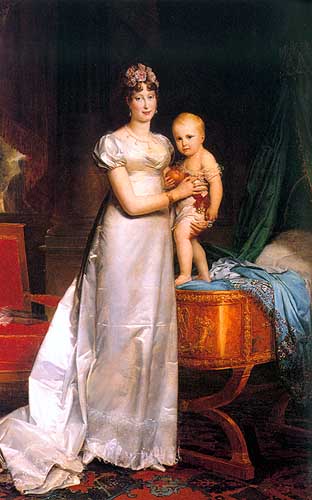
Marie-Louise with her son, the future King of Rome
During Napoleon's absence from France pursuing his ceaseless military campaigns, Marie-Louise acted as his regent in Paris. Eventually, after Napoleon's defeat and abdication in 1814, she returned to Vienna with her son. She refused to join Napoleon in his exile in Elba, something that caused serious pain of mind for the ex-emperor. The "Treaty of Fountainhead" that exiled Napoleon to the island of Elba, also granted to Marie Louise the duchies of Parma, Piacenza, and Guastalla, which was ratified by the Congress of Vienna. Marie-Louis while ruling over her domains, fell in love with Adam Adalbert, Count von Neipperg, by whom she had two children. Finally after the death of Napoleon Bonaparte in St. Helena on May 5, 1821, she married Adam Albert in September 1821.
The Coronation of Napoleon Bonaparte
Napoleon was not only a brilliant soldier but also a great patron of the arts. He also extended his patronage to the jewelry craftsmen of Paris, who turned out exquisitely crafted pieces of jewelry for the use of his court which included a wide range of jewelry for his coronation and the coronation of Empress Josephine. Napoleon engaged the services of Martin Biennais, a gifted jewelry craftsman of Paris, to create the coronation regalia and the crowns, and the coronation sword. The coronation regalia included the robe, the crown, the sword, the scepter, the orb, the chain, the ring and the ermine collar, all encrusted with the most expensive of gems and jewels. The crown was designed by Martin Biennais, to look like the medieval Charlemagne Crown, that was destroyed during the French revolution, and traditionally used by the French Monarchs for their coronations. The famous and magnificent "Regent Diamond" was set into the handle of Napoleon's coronation sword.

During the actual coronation ceremony, Pope Pius VII, first took the crown and other regalia from the altar and blessed them, and after returning them to the altar, took his seat. Napoleon then stood up from his throne and walked up to the altar, and taking the crown from the altar placed it on his head, thus crowning himself. This procedure was agreed upon earlier, as Napoleon did not want to accept the Pope as his overlord. He then walked up to the altar and removing the "Charlemagne Crown" from his head, returned it to the altar, and replaced it with a laurel wreath made of gold, of the type worn by Roman emperors. He then took the "Charlemagne Crown" from the altar again, and walking up to the kneeling Josephine placed it on her head, crowning her as the Empress of France.
The brilliance and grandeur of Napoleon's court
After ascending the throne as the Emperor of France, Napoleon organized his court, in which ceremonies took place in an atmosphere of utmost splendor and brilliance, that was imparted by the grandiose display of gems and precious stones. The grandeur and brilliance of his court even exceeded that of some of the Bourbon monarchs who preceded him, and was almost equivalent to the great pomp and pageantry displayed in the court of the great Mogul Emperor Shah Jahaan (1628-58) of India. The grandeur and extravagance reached a climax at the time of Napoleon's marriage to Archduchess Marie-Louise of Austria, on April 1, 1810.
Napoleon presents the Emerald and Diamond Parure as a wedding gift to Marie-Louise
Napoleon extended royal patronage to the jewelry industry of Paris, with a view of re-establishing Paris as a creative center for luxury and fashion, a position which it had lost following the revolution. The boost given to the industry helped in its revival and it was reported in 1807 by the Chamber de Commerce, that there were 400 jewelers in Paris, employing 800 men and 2,000 women.
One of the most experienced jewelers in Paris, at the time was Marie Etienne Ni tot, who had previously collaborated with Aubert, the jewelers to King Louis XVI and Marie Antoinette. Napoleon appointed him as his court jeweler. When Marie Etienne died in 1809, he was succeeded by his son Francois Renault as the court jeweler. As court jewelers both father and son helped Napoleon to re-assemble the jewels dispersed from the Trevor de la Couronne during the French revolution, and to acquire emeralds, diamonds and other precious stones needed for the manufacture of the expensive parures he lavished on his wives.
At the time of his marriage to Marie-Louise in 1810, it was Francois Renault who was assigned with the task of designing and manufacturing the emerald and diamond parure to be given to Marie-Louise as a wedding gift. As the emeralds that were available in the Crown Treasury were not sufficient to execute the parure he had designed, Francois Renault was compelled to make purchases of square-cut and briolette-cut emeralds weighing a total of 290 carats for the execution of the royal assignment. Examination of the "Marie-Louise Emerald and Diamond Necklace," acquired by the Louvre Museum recently, has shown that the emeralds used on the necklace were all of exceptional quality, being "loupe clean" with intense velvety-green color, and believed to have originated from the renowned Muzo emerald mines of Colombia, where emeralds were mined uninterruptedly from 1594 to the mid-18th century, when production came to a standstill due to a disastrous fire, and was not resumed until after the independence of Colombia in 1819. Francois Regnault delivered the completed parure to Marie-Louise in March 1810, just before the wedding that took place at the beginning of April. Being a gift to the empress the parure entered her personal collection and was never the property of the state.
Marie-Louise Emerald and Diamond Parure is taken to Austria after the fall of the empire
After the fall of the empire and the abdication of Napoleon in 1814, Marie Louise returned to Austria with her son. She returned all the crown jewelry in her possession to the Crown Treasury, but carried her personal jewelry to Austria. This included the Marie-Louise Emerald and Diamond Parure given to her as a gift by Napoleon for her wedding. The Parure remained with her throughout the period of her rule as the Duchess of Pharma, and at the time of her death in 1847, she bequeathed it to her Hapsburg aunt Archduchess Elise. T.
The course of inheritance of the parure from Archduchess Elise to Archduchess Alice
Archduchess Elise who was married to Archduke Rainer, son of Leopold II, bequeathed the parure to her son the Archduke Leopold, who was the godson and cousin of Empress Marie Louise. From Archduke Leopold the parure is eventually inherited by Archduke Carl Albrecht, from whom it passes on to his wife the Archduchess Alice and his son, after his death in 1951
The Regent Diamond gained its fame when Napoleon chose to decorate his battle sword with it: the stunning, mammoth diamond is 140.64 carats in size, with a very slight, blue cast. The diamond was said to be discovered at the Golonda mine in India, and spirited out secretly by a slave, who hid it within a cut on his leg. In 1792, all the Crown Jewels of France were stolen, and the Regent Diamond was among the missing gems. Napoleon retrieved the stone for his own use in 1801. Napoleon married twice, and his latter wife was an Archduchess of Austria: she went back to her home country after her husband’s death, and the Regent passed into Austrian ownership. In time, the stone returned to France, as the generous gift of the Archduchess’ father. It now rests in the Louvre, with many other spectacular gems.
Regent Diamond
A wonderful stone of Indian origin, this was originally known as the Pitt Diamond after Thomas Pitt who acquired it after 1701 under circumstances that remain murky to this day. He claimed to pay £20,000 for it and it cost £5000 and took 2 years to cut. The cleavage and dust from this process was valued at between £7000 and £8000. It finally came to France in 1717 where it was sold for £135,000, in installments. It was renamed the Regent at this point. After being stolen in 1792 (see above) along with the Hope and the Sancy (see below) it was recovered a year later and became The National Diamond of France and was pawned and became part of many complex financial deals during this turbulent period. When Napoleon Bonapart came to power it was mounted in the hilt of his sword and after his downfall in 1814, the stone traveled around quite a lot but by 1824 was back in France and worn at the coronation of Charles X. The stone is now on display at the Louvre, fortunate indeed not to have been sold with many other stones in France in 1887 and having survived the Second World War hidden behind a stone in a chateaux at Chambord.

Partial dismounting of the Marie-Louise Emerald and Diamond Diadem
Van Cleef & Arpels, who acquired the celebrated diadem dismounted the emeralds from the setting but left all the diamonds in tact. As a renowned jewelry firm they too appreciated the historic and artistic value of the diadem and therefore decided to preserve its original framework. However, the spaces occupied by the emeralds were re-set with Persian turquoises of matching sizes and shapes.
The partially modified diadem was then purchased in 1971 by Marjorie Merriweather Post (1887-1973), the owner of the Postum Cereal Company, who was America's first business woman and the wealthiest woman in America at the time, and was a socialite, philanthropist and a great connoisseur and collector of works of art. Mrs. Post then donated the diadem to the National Museum of Natural History of the Smithsonian Institution of Washington DC, where it is exhibited today at the Janet Annenberg Hooker Hall of Geology, Gems and Minerals. Other significant pieces donated by her to the Institution include a pair of diamond earrings that once belonged to the unfortunate Marie Antoinette, the 30.82-carat "Blue Heart Diamond" ring, and an emerald and diamond necklace that once belonged to Emperor Maximilian of Mexico.
